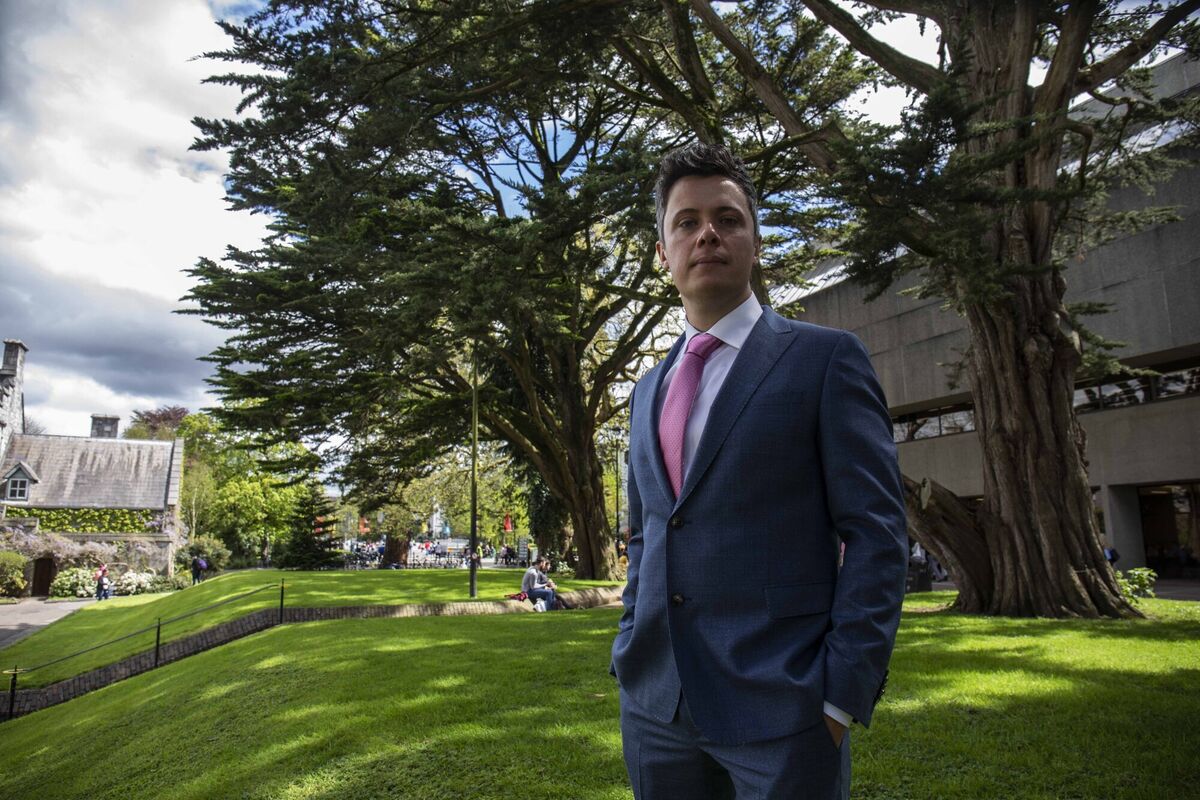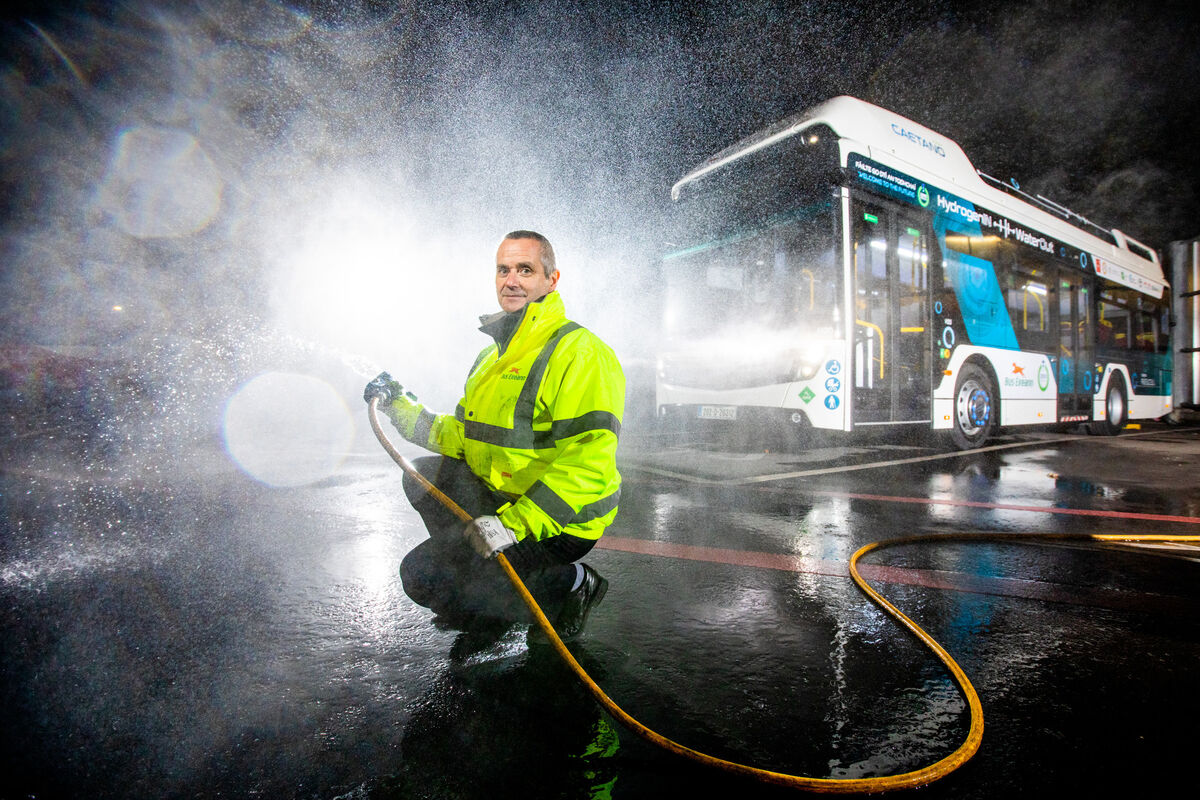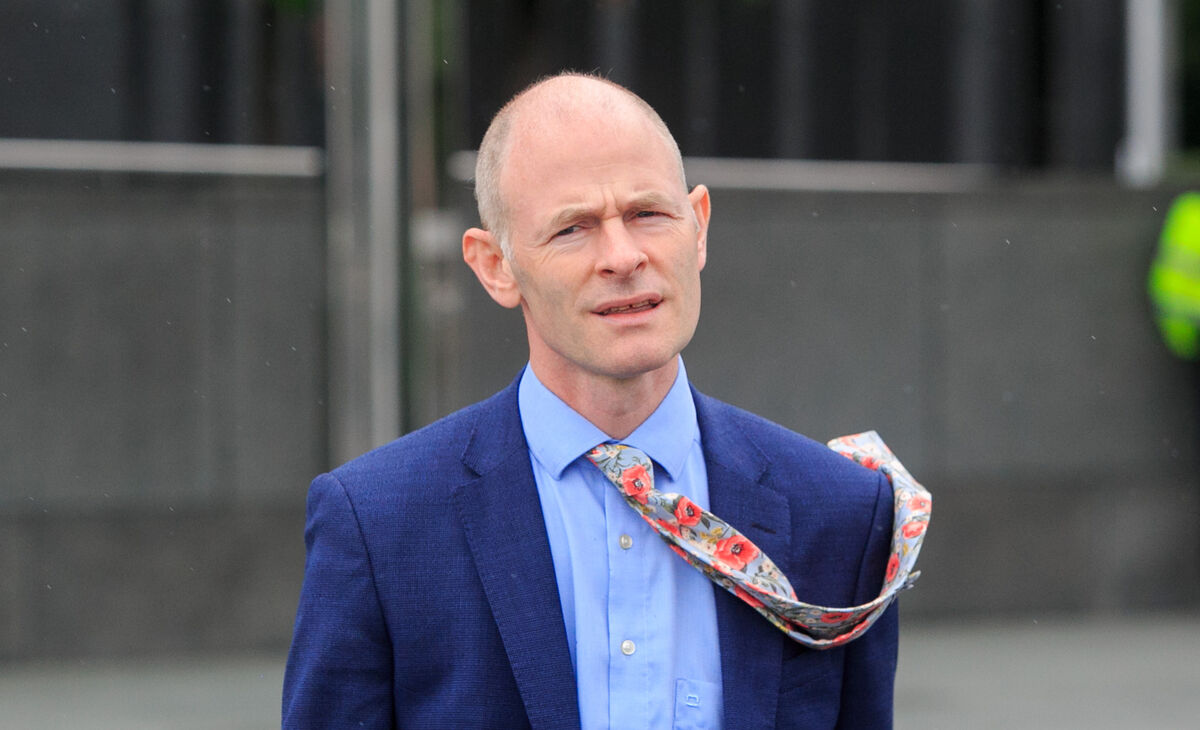Renewable island: Taking Ireland's environmental journey from concept to reality

Oil tanker Thun Gemini passes the ESB generating Station near Whitegate, Aghada, Cork, currently the most significant existing domestic user of hydrogen. Picture: David Creedon/Anzenberger
Get used to the term “green hydrogen”, because you’re going to be hearing a lot more about it over the coming years.
From being a mere conceptual clean energy possibility just a few short years ago, the enthusiasm for the possibility of producing energy through the electrolysis of water, while eliminating emissions, is growing rapidly.
Even previous skeptics are fully on board.
Earlier this year, former skeptic turned enthusiastic supporter, Cork renewable energy expert Dr Cian Desmond, said in a Wind Energy Ireland-commissioned report that "the potential for the domestic green hydrogen market is enormous".
Mr Desmond, of specialist geotechnical engineering consultancy Gavin & Doherty Geosolutions (GDG), told the Irish Examiner that he was now a "complete convert" as technology improved and associated costs plummeted.
CLIMATE & SUSTAINABILITY HUB
Its supporters say it could completely revolutionise clean energy, while its detractors have said that it is too cumbersome and costly to achieve on a mass scale.
That skepticism seems to be turning, with countries all over Europe developing green hydrogen strategies.
Cork is well-suited to becoming a leading green hydrogen region because of its geographical and climate advantages, experts have said, with major private investment already being made in recent months.
However, Ireland needs to get moving if it is to join the green hydrogen revolution.

A Sinn Féin private members Green Hydrogen Strategy Bill 2022 launched in February would compel the Minister for the Environment to draft and publish a Green Hydrogen Strategy, including a consultation, within six months.
It followed a declaration by Junior Minister at the Department of Environment, Ossian Smyth, that a public consultation on a green hydrogen strategy would be launched in the first half of the year, after first examining where the burgeoning form of renewable energy will be needed most.
It is not before time, because Ireland is lagging behind fellow European nations as one of the only countries currently without a national strategy for hydrogen, and the public consultation has still not been finalised.
Last month, Environment Minister Eamon Ryan told the Dáil that a hydrogen strategy for Ireland is a “key priority”, with a target date of the third quarter of this year 2022 for its delivery.
“The hydrogen strategy will outline the pathways towards the production of green hydrogen and its use in Ireland’s energy mix. My Department is finalising preparations for a public consultation to gather the views of stakeholders and interested parties which will inform the development of this strategy.”
Wind Energy Ireland has called for “significant resources for research and development around floating wind energy, the development of green hydrogen and emerging offshore renewable energy technologies”.
In its comprehensive report on green hydrogen from earlier this year, it said that the national strategy was vital “The concept of a hydrogen-based economy was first suggested by General Motors in 1970. The idea has seen renewed attentionin recent years driven by the increasing pressures of climate change and a lack of suitable low carbon alternatives in difficult to decarbonise sectors.
“Long term hydrogen strategies have now been published by Canada, Chile, Colombia, Czech Republic, France, Germany, Hungary, the Netherlands, Norway, Portugal, Russia, Spain, the United Kingdom, and the EU. Following COP26, the green hydrogen targets in several of these strategies are now being revised upwards. With Ireland’s own strategy currently in development, a review of the national situation is timely.”

The experts employed to carry out the report found a “definite role” for green hydrogen, Wind Energy Ireland said.
“However, early developments will be constrained by a lack of an existing domestic market for large quantities of hydrogen. We are at a disadvantage to countries such as Germany and Norway where there is the availability of both low-cost renewable electricity to produce, and significant existing industrial demand to consume, large quantities of hydrogen.
“There are two distinct opportunities for the stimulation of near-term domestic hydrogen demand in Ireland. Such early markets are vital if we are to be positioned to supply future high demand sectors such as power generation, aviation fuel, shipping fuel and a potentially vast export market.” Cork will play a massive role once green hydrogen is established, as well as the entire renewable energy industry, the report said.
“The first domestic opportunity is hydrogen injection into existing natural gas pipelines where a blend of up to 20% is considered technically achievable. Meeting this demand in Ireland would require c. 4.2 GW of wind energy generation dedicated to the production of green hydrogen.
“Whilst long term it is projected that natural gas demand will fall due to increased electrification, pipeline injection is our leading option to rapidly stimulate a domestic hydrogen market.
“Secondly, increased demand can be achieved at the only significant existing domestic user of hydrogen, the Whitegate refinery in Cork. This facility processes c. 40% of national liquid fuel demand and has been both producing and utilising hydrogen in the refining process since 1959. Part of the facility’s existing hydrogen demand is for the production of hydrogenated vegetable oil (HVO) and Fatty Acid Methyl Este (FAME), biofuels which can replace or be blended with fossil diesel.” The importance of Cork as a green hydrogen region is bolstered by the Environment Minister.
Eamon Ryan told the Irish Examiner in an extended interview that Munster would be centres of power for ramping up offshore wind and green hydrogen, with Cork Harbour and the Shannon Estuary at the forefront of the renewable revolution.
“Look at the Shannon Estuary, look at Cork Harbour, both are world-class deep-water ports. Some of our biggest energy infrastructure —like Whitegate, Aghada refinery and power generation, all the big biopharma plants — will all be looking for clean energy sources. If we have that offshore power coming ashore there, if we can convert it to hydrogen, and use that as an energy stock. We used to make fertiliser in Cork Harbour, net nitrate. With ammonia, does that not give us the ability to convert that wind into the likes of those sort of products and export them or use them for ourselves?” he said.
Wind Energy Ireland says that in order to increase green hydrogen demand at the Whitegate facility, close consultation with the operators is critical to overcome technical and regulatory barriers.
This would allow the rapid increase of biofuel production up to and beyond the Climate Action Plan target of 20% by 2030, it said.
“Low carbon transport fuels are the first markets where hydrogen can compete directly with fossil fuels. As such, the Whitegate facility is expected to be central to the early development of Ireland’s green hydrogen economy and it is important that existing expertise and infrastructure are leveraged.”
Whilst focusing on the domestic market pre-2030 may be seen as lacking ambition, Wind Emergy Ireland said, it should be noted that the potential scale of this market is significant.
“If just heavy goods vehicles and buses were to switch from diesel to green hydrogen it would require at least 1.4GW of dedicated wind energy generation. Synthesising just 50% of shipping and aviation fuels would require a further 6.6 GW. The construction of the required wind farms and the electrolysis alone would require an investment of c. €18.4 bn, resulting in the generation of approximately 16,000 direct and a further 32,000 indirect jobs.
“Currently, talent gaps and employment opportunities related to green hydrogen are primarily related to energy systems modelling, planning and the analysis of energy/carbon regulations. Our stakeholder survey indicates that as the industry develops, we will see significant employment opportunities in construction and skilled technical roles.
Long-term employment opportunities will be found in the operation of facilities along with the provision of services and expertise to the global green hydrogen industry. By focusing on near-term opportunities and working with the existing hydrogen expertise at our disposal, Ireland has the potential to be a leader in green hydrogen utilisation. Reducing our carbon footprint, building energy security, and providing long-term sustainable employment opportunities.”

However, this bolsters the need for Ireland to get out of the starting blocks. Just looking at other European nations tells you they are foraging ahead while we wait.
“In Europe, Germany is at the forefront of green hydrogen research, with the difficulties that the country has experienced in accommodating wind energy (losing 5.5TWh of power in 2017, which cost an estimated €1 bn) providing additional motivation.
“Germany recently approved a further 10 years’ worth of research funding (totalling €1.4 bn), which includes subsidies for public hydrogen refilling stations, fuel cell vehicles, fuel cell home appliances, and support for the first commercial operation of a hydrogen-powered train. These developments are set to be supported by an additional €2bn in private investment,” the Wind Energy Ireland report warned.
What exactly can be powered by green hydrogen? Lots, according to the experts.
“Although it is unlikely that hydrogen will play a role in the Irish home heating or passenger car market, there are many other sectors where green hydrogen technology can be utilised,” Wind Energy Ireland said.
Take Heavy Goods Vehicles (HGVs), which currently account for 15% of transport energy demand and are almost entirely reliant on diesel.
“HGVs are also an increasing source of emissions and their energy demand is set to double by 2050. Despite a lack of specific emissions reduction target, it is clear that a low-carbon solution to the HGV problem is urgently required.
“For the largest vehicles, which typically have much greater daily mileage which makes them much more difficult to electrify, hydrogen has several key advantages: It can offer refuelling practices similar to diesel and natural gas, with similar range and performance.”
Buses are also an intriguing possibility, the report said “This is also true for buses, for which centralised hydrogen refuelling can match existing practices and hence replace the current system with less resistance to change, even potentially achieving cost parity in Dublin by 2030.
“There are currently three hydrogen fuel cell buses operating in Belfast, and a successful trial has also been performed in Dublin in what could be the first steps toward a wider rollout of the technology.
“For just one large HGV, the hydrogen required to complete a return trip from Dublin to Cork would require 0.7MWh of electrolysis. At present, there are approximately 25,000 such vehicles on Irish roads, a number which is growing rapidly and, as such, the scale of the hydrogen opportunity in this sector is substantial.”
The expertise is there, the will is there, and the enthusiasm growing – it's now time for the political sphere to match that and see where the green hydrogen revolution takes us.













